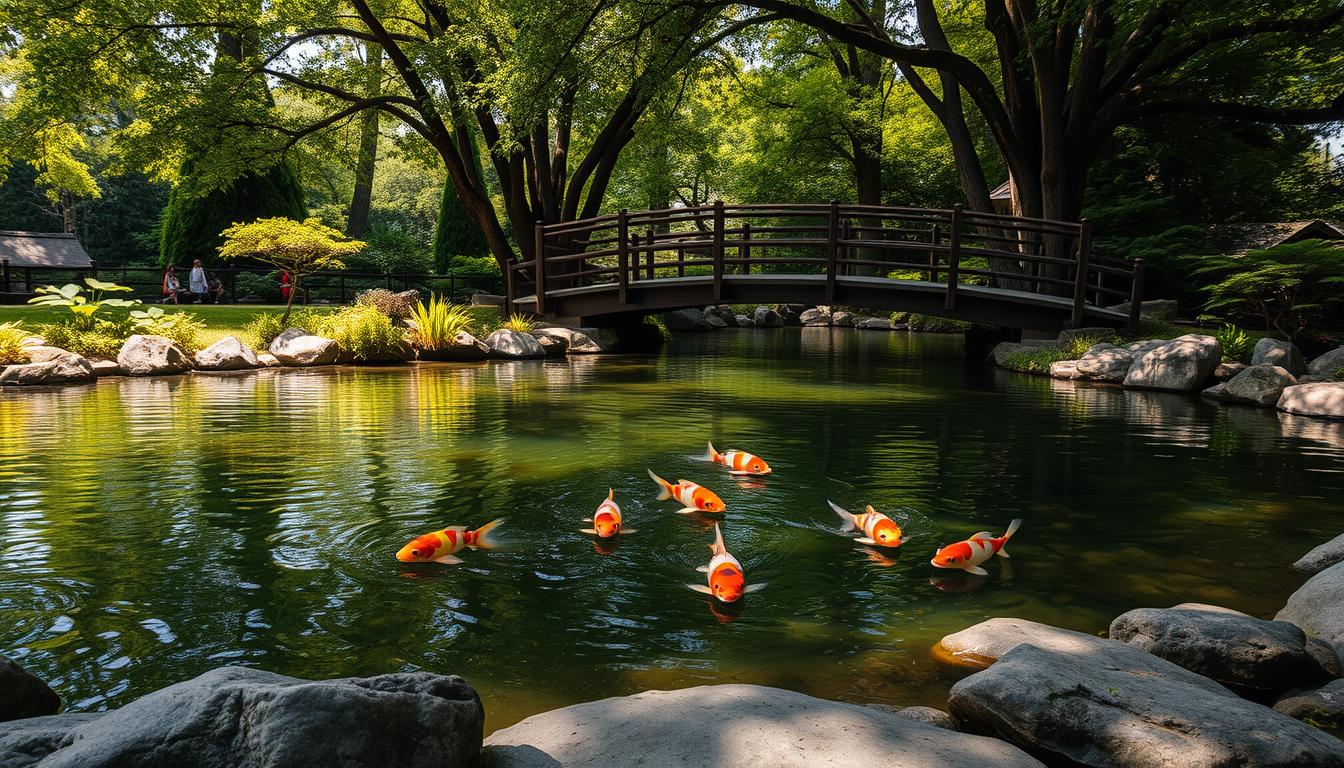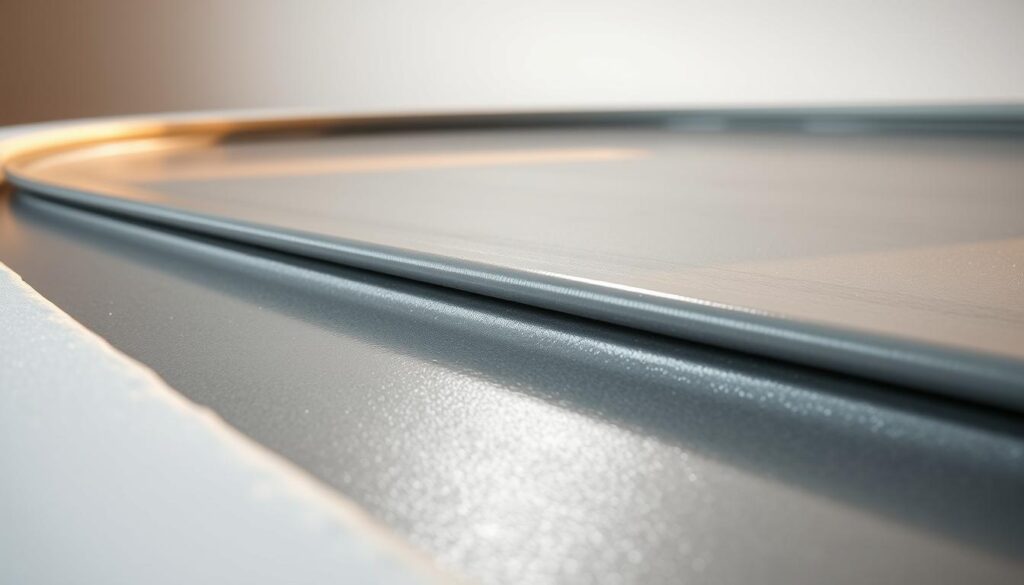
Discover the step-by-step process we use to design and construct a lasting water feature for your home and landscape. From initial goals and site study in your garden or backyard to CAD drawings and permits, we make sure every dimension and elevation is correct before construction begins.
Our approach pairs reinforced concrete with polyurea waterproofing to meet strict local codes and create durable shells. We specify technologies like bottom drains, UV sterilizers, aerators, bead filters, and settling tanks to remove solids, manage waste, and keep water clear. This system keeps circulation steady and boosts oxygen for healthy fish.
You’ll see how careful planning, precise construction, and clear maintenance training reduce surprises and long-term costs. We also cover timelines, startup guidance, and simple routines that help owners enjoy the feature from day one.
Key Takeaways
- Planned process: Goals, site study, CAD, permits, then build.
- Durable construction: Reinforced concrete plus polyurea for lasting shells.
- Reliable filtration: Drains, bead filters, and UV keep water clear.
- Fish health: Circulation and aeration raise oxygen and comfort.
- Owner-ready: Startup coaching and simple maintenance routines.
- Transparent timeline: Milestones and clear expectations reduce risk.
What to Expect from a Custom Koi Pond Build
You’ll get a step-by-step plan that maps design, equipment, and construction milestones. The process starts with a site consultation and CAD drawings, then moves to permitting and installation. Timelines are clear so you know how long each phase will take and what to expect at your home.

Modern systems use bottom drains, bead filters with UV, aerators, skimmers, and settling tanks to keep pond water clear and oxygenated. With proper hydraulic design, these elements let higher fish loads thrive while reducing routine maintenance.
We specify full equipment lists up front to simplify bidding and avoid surprises. Builders who provide CAD plans and owner training help protect budgets and cut long-term costs.
- Predictable performance: clearer water, more oxygen, better fish health.
- Design collaboration: visibility, lighting, and aesthetics balanced with reliability.
- Owner-ready: simple maintenance tasks and post-build support.
Planning the Site and Design for Your custom koi pond
Site planning sets the stage for a durable water feature that fits your backyard, sunlight patterns, and maintenance needs.
Choosing the ideal backyard location, sun exposure, and access
We walk your backyard to select the best area, studying sun exposure to limit algae and wind patterns that push surface flow toward skimmers.
Trees and garden elements are reviewed to balance shade, leaf drop, and root risk. We also mark clear equipment access for construction and future service.
Right-sizing depth, width, and shapes for koi health and space
We size the pond’s length, width, and feet of depth to match fish counts and growth. Proper shapes promote even circulation and safe swimming lanes.
Bottom contouring and drain placement are set to encourage self-cleaning flow and reduce manual debris removal.
From concept to CAD: design coordination, permits, and code considerations
Once the design is agreed upon, professional CAD drawings fix elevations, equipment pads, and lighting conduit locations.
We sequence permits to meet California code and local soil realities, specify pipe sizing to avoid clogs and excess energy, and plan plantings and hardscape so plants complement filtration.

Groundwork and Structure: Excavation, Base, and Forming
The true strength of any pond comes from its foundation: measured excavation, stable base materials, and flow-ready shaping. This step sets the size and feet of depth and protects nearby structures and utilities.
Excavation and subgrade preparation
We dig to engineering marks and bench the sides to hold exact dimensions. Subgrade is compacted and shaped with continuous slopes and radiuses that guide debris to bottom drains.
Reinforcement and structural build
Clean gravel stabilizes plumbing trenches and prevents point loads under the shell. Plumbing for drains, jets, skimmers, and returns is pressure-tested before formwork is assembled.
- Precise depth control: confirm size and feet of depth per plan.
- Durable shell prep: rebar and formwork installed to schedule for a monolithic structure.
- Embed review: set penetrations and verify clearances for settling tanks and prefilters.
Quality checks on slopes, radiuses, and penetrations reduce dead zones and ease long-term maintenance for fish and equipment.
Waterproofing That Lasts: Liner Alternatives and Polyurea Systems
Choosing the right barrier is the most important step to keep water where it belongs and protect the structure beneath. Experienced builders pair reinforced concrete shells with spray-applied polyurea to meet strict California code and deliver lasting performance.
Why choose a reinforced shell plus polyurea over a liner?
- Puncture resistance: sprayed polyurea bonds to concrete and resists tears better than most sheet liners.
- Adhesion and longevity: proper surface prep and priming yield a durable coating that outlasts many liner systems.
- Seamless finish: continuous membrane reduces seam failures and lowers long-term risk in water features.

Detailing penetrations and transitions
Penetrations for bottom drains, skimmers, returns, and lights get mechanical locks and gaskets, then are sealed in multiple passes. Coving and fillets smooth corners so the coating bridges right angles and keeps water in the structure.
Movement joints, steps, and niches
Movement joints, benches, and fish caves are treated so the membrane remains continuous at complex shapes. Final QA tests include holiday checks and visual inspection before any filling.
Underwater lighting for nighttime visibility
Lighting placement matters. Niches aimed at fish improve nighttime viewing from your home and reduce surface glare that hides color and movement. Depth plans that include shallow two feet deep zones and deeper swims are coordinated with lighting and safety.
When a liner still makes sense: in limited cases a sheet liner offers easier repairs and lower initial cost. We review trade-offs in durability, aesthetics, and long-term risk so owners can choose the best way forward for their construction project.
Filtration and Circulation: The Heart of Koi Health and Clear Water
Well-designed circulation systems move solids and oxygen where they belong to keep clear, healthy water.
Bottom drains and directed jets sweep the floor so debris travels toward the prefilter train instead of settling. Placing drains at low points and aligning jets to create gentle sweeps reduces manual cleaning and helps fish stay in clean swims.
Skimmer, prefilter, and settling tank
A properly located pond skimmer pulls floating waste to the weir before it waterlogs and sinks. A settling tank or prefilter captures heavier solids upstream of the main filter, lowering maintenance and protecting media life.
Bead filter and UV sterilizer
Bead filters with UV polish water and cut free-floating algae and pathogens. Mechanical removal plus UV disinfection keeps pond water clear and reduces stress on fish.
Pumps, pipe sizing, and hydraulics
Pumps are selected for design flow and efficiency. Correct pipe size and smooth sweeps prevent clogs and cut energy use. Valves, unions, and purge points make service quick and keep pumps running well.
Aeration and beneficial bacteria
Aerators and diffusers raise oxygen so fish and beneficial bacteria thrive. Stable oxygen supports biofiltration and helps the whole system resist spikes in waste and algae.
“Balanced flow and reliable filtration are the single best investment for long-term clarity and fish health.”
- Strategic returns and optional waterfall flows reduce dead zones.
- Protective gravel layers can shield drains without blocking flow.
- Packaged equipment layouts simplify installation and support.
Startup and Cycling: Building a Stable Pond Ecosystem
After construction ends, the final handoff focuses on biological startup so the system can support healthy fish. This step-by-step process conditions water, matures filters, and reduces risk during early stocking.
Seeding beneficial bacteria and timing your first water changes
We begin with dechlorination as needed and seed beneficial bacteria to kickstart the biofilter. Early, staged water changes stabilize pond water while the bacteria colonies establish.
Water testing, chemistry balance, and filter maturation
Test pH, ammonia, nitrite, and nitrate daily at first, then weekly as readings steady. Track trends so small adjustments protect fish health while the filter media matures.
Introducing koi fish safely and monitoring early behavior
Acclimate koi fish slowly to temperature and pH, watch gill movement and swimming, and keep lighting subdued. Pace feeding to avoid overloading immature filters and reduce oxygen dips.
- Simple maintenance: rinse prefilters, avoid scrubbing main media, and clear trapped debris from gravel locations.
- As the ecosystem balances you will see clearer water and steadier readings — a signal it is safe to add stock over time.
“Start slow, test often, and let biology do the work.”
Landscape Integration, Aquatic Plants, and Predator Protection
Integrating aquatic planting and predator defenses gives you beauty without sacrificing fish safety. Thoughtful planting can boost filtration while keeping open water for viewing and circulation.
Selecting aquatic plants and soils that complement filtration
We choose aquatic plants and aquatic soils that support biological filtration and shed little debris. Plant baskets and marginal beds sit where flow carries detritus to the pond skimmer rather than clogging it.
Plant groupings frame views, stabilize edges, and keep open swims so koi and fish remain visible. Specialists size beds and soil mixes to avoid nutrient spikes that encourage algae.
Depth, fish caves, and netting to deter herons and raccoons
Predator protection starts with structure. Sections at least two feet deep and swims around eight feet wide reduce wading by herons and give fish room to escape.
Integrated fish caves and steep edges provide quick shelter for fish. For exposed sites, suspended netting, motion-detector sprinklers, or decoy herons add extra defense.
“A well-planned landscape protects fish and keeps your garden looking its best.”
- Manage trees and surrounding garden to limit leaf drop and root intrusion.
- Coordinate plant density and space so water flows evenly around marginal beds.
- Plan lighting and pathways to enhance nighttime viewing without inviting predators to shallow margins.
Owner Handoff: Maintenance, Upgrades, and Long-Term Care
A clear handoff turns systems into simple habits so owners spend less time on chores and more time enjoying their water. We document routines, map equipment, and schedule checks so responsibilities are easy to follow.
Clear water guarantee, filtration upgrades, and service training
We back the build with a clear water guarantee and focused training. At handoff we show prefilter cleaning, valve operations, pond skimmer checks, and basic water testing. These quick routines make maintenance manageable.
As fish grow, filters may need an upgrade. We review filtration paths and recommend filter or pump changes to match biomass. Periodic reassessments help ponds stay clear without adding time to care.
- Service training on filter sequence, pump priming, and seasonal tasks.
- Options for maintenance plans, remote support, and scheduled water chemistry rebalances.
- Documentation of equipment locations, spare parts, and vendor contacts for fast service.
“Start with training and a plan—then routine keeps water clear and fish healthy.”
Conclusion
strong, Good design focuses on flow paths, reliable equipment, and easy owner routines so the system performs year after year.
Follow each step—from planning and structure to waterproofing, filter sequence, and startup—to build a reliable koi pond that stays clear and long-lived.
Thoughtful choices like correct bottom contouring, the right number of drains and jets, and pumps sized for efficient flow cut debris and energy use.
Reinforced shells with advanced coatings beat basic liner options for durability. Stable mid-range chemistry and seeded beneficial bacteria keep fish healthy. Simple testing and filter service preserve the ecosystem and let you enjoy the water feature in your backyard or garden.








